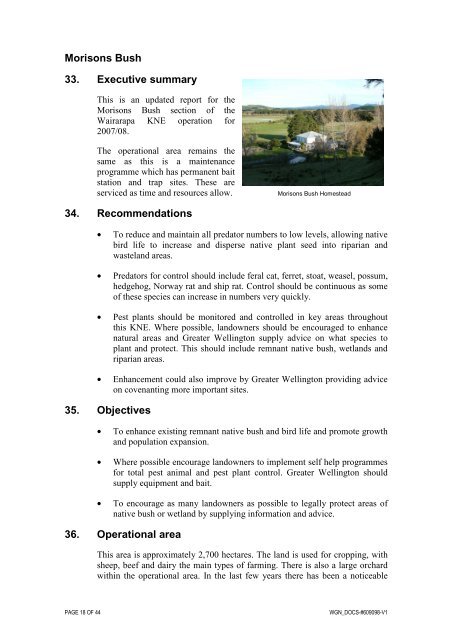Wairarapa Key Native Ecosystem Management Areas - Greater ...
Wairarapa Key Native Ecosystem Management Areas - Greater ...
Wairarapa Key Native Ecosystem Management Areas - Greater ...
You also want an ePaper? Increase the reach of your titles
YUMPU automatically turns print PDFs into web optimized ePapers that Google loves.
Morisons Bush<br />
33. Executive summary<br />
This is an updated report for the<br />
Morisons Bush section of the<br />
<strong>Wairarapa</strong> KNE operation for<br />
2007/08.<br />
The operational area remains the<br />
same as this is a maintenance<br />
programme which has permanent bait<br />
station and trap sites. These are<br />
serviced as time and resources allow. Morisons Bush Homestead<br />
34. Recommendations<br />
• To reduce and maintain all predator numbers to low levels, allowing native<br />
bird life to increase and disperse native plant seed into riparian and<br />
wasteland areas.<br />
• Predators for control should include feral cat, ferret, stoat, weasel, possum,<br />
hedgehog, Norway rat and ship rat. Control should be continuous as some<br />
of these species can increase in numbers very quickly.<br />
• Pest plants should be monitored and controlled in key areas throughout<br />
this KNE. Where possible, landowners should be encouraged to enhance<br />
natural areas and <strong>Greater</strong> Wellington supply advice on what species to<br />
plant and protect. This should include remnant native bush, wetlands and<br />
riparian areas.<br />
• Enhancement could also improve by <strong>Greater</strong> Wellington providing advice<br />
on covenanting more important sites.<br />
35. Objectives<br />
• To enhance existing remnant native bush and bird life and promote growth<br />
and population expansion.<br />
• Where possible encourage landowners to implement self help programmes<br />
for total pest animal and pest plant control. <strong>Greater</strong> Wellington should<br />
supply equipment and bait.<br />
• To encourage as many landowners as possible to legally protect areas of<br />
native bush or wetland by supplying information and advice.<br />
36. Operational area<br />
This area is approximately 2,700 hectares. The land is used for cropping, with<br />
sheep, beef and dairy the main types of farming. There is also a large orchard<br />
within the operational area. In the last few years there has been a noticeable<br />
PAGE 18 OF 44 WGN_DOCS-#609098-V1
















